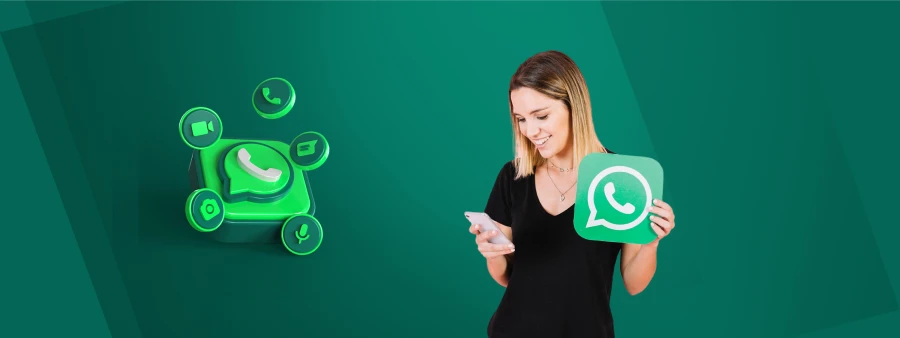Human handover: Seamlessly transfer chats to Live Agents
Co-browsing: Eliminate confusions
No-code: Build your chatbot effortlessly
Get Started for FreeNo credit card required

What is the best way to improve growth in your business?
Apart from adopting the latest technology and tools, improving customer experience is also a top priority. Marketing Insider Group says, “80% of U.S. customers would pay more for a product or service to ensure a superior customer experience”. Businesses that deliver a great customer experience (CX) outgrows those do not.
A great CX strategy makes your existing customers more valuable by improving the customer life cycle while at the same time making it easier and less costly to acquire new customers. CX being the pulse of every business touches all facets ranging from customer satisfaction, loyalty, and brand positioning.
So, now the question is which channel provides the most RoI (return of investment) when it comes to delivering the best customer experience? Live chat is by far the best channel for increasing customer experience. Forrester says, “30% of customers expect live chat on your website.”
The bottom line is that businesses can enhance live chat customer engagement significantly that boosts customer satisfaction. But before we go deeper into how it impacts CX, let us understand what is live chat and how it works?
Live chat has many benefits to boost sales conversion and accelerate the growth of your business. Let’s discuss some practical strategies to use live chat for customer engagement that will deliver an exceptional customer experience.
Websites are the main source of your brand image. Visitors interact first with your brand via the website. Live chat offers a great opportunity to engage website visitors while they are on your site. It increases website conversions by 45% because of offering instant customer service.
How to use live chat sales assistance to increase customer experience?
Businesses can track their website visitors and effectively convert them into leads by triggering right and timely messages. If you offer better customer experience to your first time visitors, they will become your potential customers.
Emarketer says, “63% of customers were more likely to return to a website that offers live chat”.
Integrating live chat with CRM software collects and stores information such as contact details, order history from all the website visitors and customers to build customer profiles. It becomes easy for your agents to access the customer profiles when they return to chat again.
Protips:
Response time plays a vital component of good customer service. 82% of consumers say the number one factor that leads to a great customer service experience is having their issues resolved quickly.
Generally, most of the customers abandon an online transaction if their questions or concerns are not addressed fast. The two most common customer service frustrations are:
Live chat is the most preferred software by businesses to deliver real time responses to customers. It is a complete customer service toolkit that includes live engagement tools like co-browsing and video chat that delivers interactive support experience.
How does live chat support enhance customer experience?
Businesses implementing the best live chat solution has witnessed a significant speed in responding to customers. When the response time is less, it means better customer satisfaction.
Tips to follow:
With chatbot automation, you can enhance live chat customer satisfaction by handling simple queries 24×7. It works hand in hand with agents by collecting customer details before transferring the conversation to the right agent.
Innovation & Digital Transformation leader Oliver Laborde says “Chatbots are making their way into the landscape of customer relations with the opportunity and promise to offer a better customer experience.
“Chatbots are key tools of good integrated customer experiences.” – Olivier Ezratty
Bots help to deliver a great customer experience by following ways:
For example, Funds tiger launches chatbot for loan purposes.
Protips to deliver a hybrid customer experience:
Live chat benefits are so many that they can greatly impact your business. It allows instant connection with the customers and hassle-free resolution with live engagement tools. Automating the tasks reduces the manual intervention and extra hours gained can be used to provide better customer service to boost the customer experience.
Employing such strategies helps to boost team productivity which will influence customer experience.
Protips:
Customer Think says customer satisfaction ratings for live chat are often higher than all other support channels, likely because of the speed and conversational nature, with chat being the preferred support channel by millennials.
Live chat software helps to communicate instantly without letting the customer wait for a long time. The chat conversations can be made interactive by using face-to-face video chat and co-browsing for a better live chat customer experience.
Co-browsing solution helps customer service agents to interact with and guide customers in order to deliver a better customer experience. Find out how interactive customer engagement benefits the customers:
Tips to boost live chat customer satisfaction:
Do you remember how many times you reached out to a company’s help desk number and all you got was an annoying robotized voice repeating the instructions?
Live chat is one of the best website chat app tools that can humanize your customer support. With live chat, you are free from such an annoying robotic experience and you get connected with a human agent for personalized support.
Precisely, this is one of the crucial reasons why 92% of clients feel satisfied while using live chat for customer engagement.
So how does live chat bring a human touch to enhance the conversational customer experience?
Making conversations personalized and interactive by using visual engagement tools deliver an outstanding customer experience.
Tips for improving customer engagement with live chat:
Running a business means pleasing your customers, meeting their requirements, and keeping them loyal to your brand. At the same time learning customers’ opinions is equally important to deliver the best customer experience. Feedback help to identify the gaps between customers and businesses.
Customer feedback plays a vital role in many business facets:
Live chat is an important channel for customer feedback and gaining more preference because it is the best way to ask customer feedback through rating customer service. Asking customer feedback immediately after a demo or live chat session is the best practice.
How feedback helps to enhance live chat customer experience?
Measuring customer satisfaction comes down to collecting customer feedback via different methods (surveys, polls). You can receive customer feedback through email or during a live chat with a rating view after the session ends successfully.
Tips to increase customer satisfaction with live chat:
In-app messages boost engagement by 3x!
Providing in-app support, right inside your web or mobile app, is a great way to drive higher user engagement and product support. If you are a SaaS product, there are high chances that your customers may look for help when they are inside your product.
So when it comes to delivering great customer experience, quality product support is one of the key factors for a software business that drives its customer retention. There are a few areas where live chat messaging is a key contributor to increasing your customer retention.
Sounds a bit exaggerated? Well, as per the Walker report, “Customer experience will surpass these attributes as a key differentiator by 2023.”
Tips to enhance live chat customer experience:
Customer experience (CX) is a critical factor in the success of your business. A business with great CX is better able to satisfy customers and assures they continue to return again in the future. Customer experience must be evaluated through the complete service delivery chain starting from initial customer contact to remote support to on-site technician service, and follow-up.
To deliver an amazing customer experience, brands must develop best-in-class processes, create new and unique ways of interacting with customers, and invest in technology to optimize these touchpoints. With live chat, you open gateways for customers to reach you instantly and for customer experience.
Start a 14-day free trial, no credit card required
Stay updated with the latest trends and ideas we share

What if you could use a channel that helps you reach your customers instantly and directly anytime you like? On...

Businesses face numerous challenges in reaching and engaging their target audience effectively. How can you make the process easier to...

Traditional banks are transitioning into digital banks, with artificial intelligence in banking becoming increasingly popular. Approximately 35-40% of banks are...